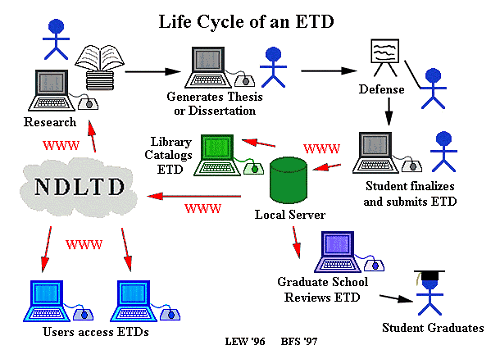Excerpted: Electronic Theses and Dissertations: Digitizing Scholarship for Its Own Sake
Skip other details (including permanent urls, DOI, citation information): This work is protected by copyright and may be linked to without seeking permission. Permission must be received for subsequent distribution in print or electronically. Please contact [email protected] for more information.
For more information, read Michigan Publishing's access and usage policy.
Formats for ETDs
 Lifecycle.gif courtesy of Virginia Tech ETD Project
Lifecycle.gif courtesy of Virginia Tech ETD ProjectMost students already prepare their theses or dissertations electronically, using computers and word-processing software. Formats proposed to make ETDs easily viewable through different platforms include the use of PDF (or Print Document Format) files created with Adobe Distiller. That software creates an exact, digitized picture of a document, page by page, including any graphics and fonts. The file can then be downloaded and viewed using the Adobe Reader, available free on the Web. PDF documents retain all formatting and graphics and also allow the author to include links to other sites on the Web or annotations within the article. In addition, Adobe files can be indexed easily and searched by keywords specifically chosen by the author or indexer. PDF documents available on the Web may also be searchable using words or phrases found anywhere within the document, thus greatly facilitating a researcher's task. For larger and more complex documents, Virginia Tech encourages submission of ETDs in LaTeX or TeX format. LaTeX and TeX are device-independent document formatting systems that use PostScript fonts. They are particularly useful for formatting complex mathematical equations in electronic documents. Those files are then converted to PDF format.
ETD-ML, or Electronic Thesis and Dissertation Markup Language, is another format used by Virginia Tech for submission of ETDs. ETD-ML is actually a form of SGML, or Standard Generalized Markup Language, which uses tags to embed formatting codes in a document. Hypertext Markup Language (HTML), the language of Web documents, is a variety of SGML that uses similar specialized tags. SGML allows for the "exchange of information at any level of complexity among software, hardware, storage and presentation systems (including database management and publishing applications) without regard to the manufacturer's name on the label" (SoftQuad). That makes it portable across platforms. The strength of SGML for publishers is its use of document-type definitions, or DTDs, which allow a publisher to specify exactly what the document will look like by defining tags for that particular document type. The Electronic Text Center at the University of Virginia already makes available thousands of text files marked up with SGML, which are automatically converted to HTML when accessed by the user so they can be read online with a Web browser such as Netscape.
ETDs are still placed with UMI, giving researchers the option of accessing them in print or microform. While interactive ETDs cannot easily be reproduced with print and microform, those options ensure access to many important works by a wide variety of researchers. UMI now makes electronic versions of journals and other publications available online and via other electronic means, and it is likely that the company will one day provide full-text copies of ETDs as well.
